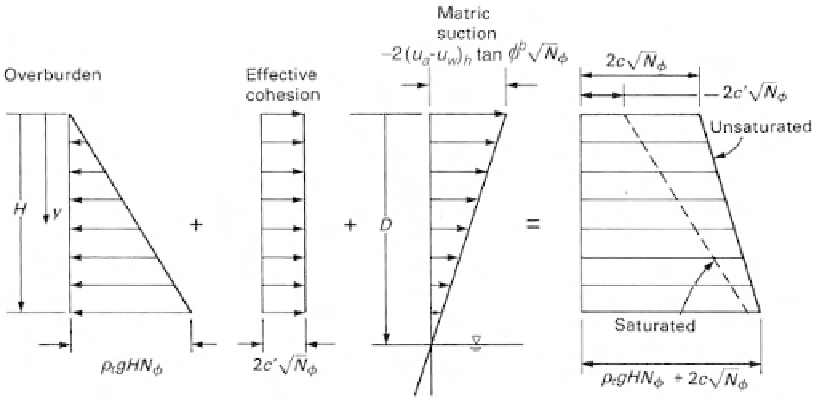Environmental Engineering Reference
In-Depth Information
written as a linear equation (Eq. 12.49). For this matric suction
distribution, the passive pressure
p
p
can be written as
2
c
N
φ
p
p
=
(σ
v
−
u
a
)N
φ
+
u
w
)
h
tan
φ
b
1
N
φ
y
D
+
2
(u
a
−
−
(12.56)
The passive pressure distribution along with a plot of the
components is shown in Fig. 12.50. The existence of tension
cracks in the soil is not of relevance for the passive pres-
sure case. The assumption is made that the cracks would
close and the soil mass would become intact as the passive
pressure is applied.
12.3.13 Deformations Associated with Active
and Passive States
Studies by Terzaghi (1954) showed the relationship between
the movement of a wall and the earth pressure coefficients
for dense and loose sands (Fig. 12.51). Most unsaturated
soils behave similar to a dense soil in that relatively low
displacements are required to develop the active and passive
states. The results indicate that displacements as low as
0.001
H
(where
H
is the height of the wall) are required to
develop the active state in a dense soil. More displacement
is required to develop the passive state.
Lambe and Whitman (1968) presented triaxial test results
on a dense sand and summarized the percent strains required
for the active and passive states. It was concluded that
strains on the order of 0.5% can produce the active state.
Under compressive loading, strains of 0.5% develop about
one-half of the passive resistance. As much as 2% was
required to reach the full passive resistance for dense sand.
Figure 12.52 illustrates the difference between the active
Figure 12.51
Relationship between movement of wall and earth
pressures developed for varying soil densities (from Terzaghi,
1954).
and passive stress paths. The larger stress changes associ-
ated with the development of the passive state is one of the
reasons for a larger strain at failure.
Strains at failure in unsaturated soils might be quite dif-
ferent from those mentioned above because of unusual
K
0
Figure 12.50
Components of passive earth pressure distribution when matric suction decreases
linearly with respect to depth.














Search WWH ::

Custom Search